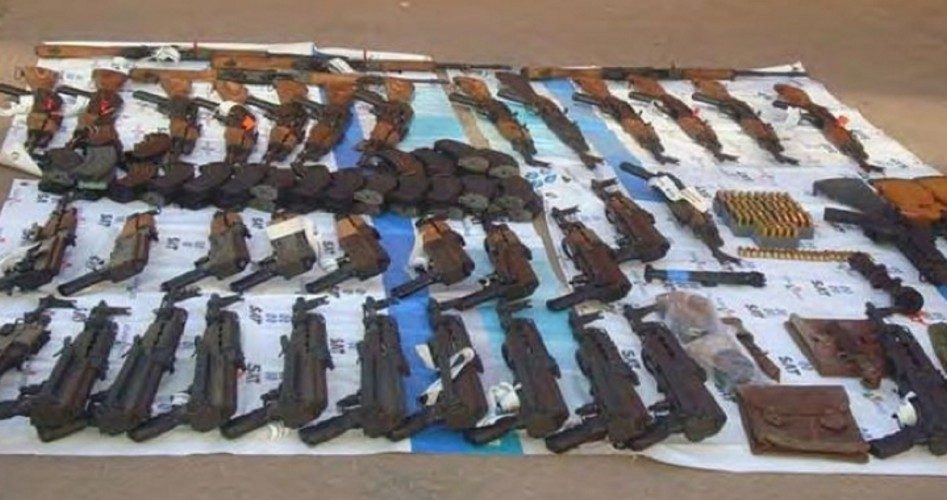
Chalk up two more victims for the Obama administration’s Operation Fast and Furious. According to the Los Angeles Times, Justice Department records show that a high-powered rifle sold to a straw buyer as part of the “gunwalking” program was used to kill a Mexican police chief and his bodyguard earlier this year.
“Luis Lucio Rosales Astorga, the police chief in the city of Hostotipaquillo, was shot to death Jan. 29 when gunmen intercepted his patrol car and opened fire,” the Times reported. “Also killed was one of his bodyguards. His wife and a second bodyguard were wounded.”
Eight suspects, members of drug cartels in the area, were arrested after police found them nearby with a cache of weapons. Some of the suspects have confessed to other shootouts in the area, according to local officials.
Among the weapons found in their possession was the semi-automatic WASR rifle that was used to kill the police chief. That rifle was traced back to the Lone Wolf Trading Company, a gun shop in Glendale, Arizona, that the Bureau of Alcohol, Tobacco, Firearms, and Explosives (ATF) used in Fast and Furious, deliberately permitting illegal purchasers to obtain guns there allegedly so that the bureau could trace the guns to Mexican drug cartel leaders.
“The notation on the Department of Justice trace records,” wrote the Times, “said the WASR was used in a ‘HOMICIDE – WILLFUL – KILL – PUB OFF – GUN’ — ATF code for ‘Homicide, Willful Killing of a Public Official, Gun.’”
The murder weapon “was purchased on Feb. 22, 2010, about three months into the Fast and Furious operation, by 26-year-old Jacob A. Montelongo of Phoenix,” said the newspaper. Montelongo ended up buying “at least 109 firearms during Fast and Furious,” and “later pleaded guilty to conspiracy, making false statements and smuggling goods from the United States and was sentenced to 41 months in prison.”
Mexican authorities claim that 211 people have been killed by Fast and Furious weapons thus far in Mexico. Most of those murders have taken place near the U.S.-Mexico border. But Hostotipaquillo, in the state of Jalisco, is nearly 1,000 miles from Phoenix, “suggesting that weapons from the failed gun-tracking operation have now made it into the hands of violent drug cartels deep inside Mexico,” the Times observed, noting that it is “unclear” how the rifle ended up there.
While Mexicans have suffered the most because of Fast and Furious, at least one American, U.S. Border Patrol Agent Brian Terry, is also a probable victim: A gun sold illegally through the operation was found at the scene of Terry’s December 2010 homicide.
The fact that, as the Times pointed out, “almost all the weapons [sold in Fast and Furious] were lost as they flooded across the border into Mexico” suggests to some that the operation had little to do with capturing Mexican drug lords. As Examiner.com’s Kurt Hofmann put it, “We are being asked to believe that the [ATF]’s grand strategy for bringing down the drug cartels … [went] something like this:”
Phase 1: Encourage gun dealers (and sometimes pay them, as confidential informants) to sell guns to known traffickers
Phase 2: ?
Phase 3: Humbly accept plaudits as Mexican drug cartel comes crashing down
Might the purpose of Fast and Furious instead have been to make the case for gun control in the United States? Certainly the Obama administration has not been shy about taking advantage of domestic firearms tragedies to push for greater restrictions on gun rights. In fact, on the second anniversary of Terry’s death, Attorney General Eric Holder said, “As a nation I think we have to ask ourselves some hard questions. We gather too often to talk about these kinds of incidents. We need to discuss who we are as a nation, talk about the freedoms that we have, the rights that we have and how those might be used in a responsible way.”
Holder was talking about the shootings at Sandy Hook Elementary School in Newtown, Connecticut. However, his department, through Fast and Furious, is directly responsible for the deaths of vastly more people than died at Sandy Hook, yet no federal officials have been prosecuted for their participation in the program, and the administration has repeatedly stonewalled requests for relevant documents. Holder’s recalcitrance proved so great that the House of Representatives actually held him in both civil and criminal contempt of Congress — the latter charge requiring prosecution that the U.S. attorney for the District of Columbia has thus far refused to undertake.
While the administration circles the wagons around Holder and the ATF and continues to call for restrictions on Americans’ right to keep and bear arms, Fast and Furious, which officially ended two years ago, is still claiming new victims. Is it any wonder, then, that many Americans suspect that the administration is far more concerned about disarming law-abiding Americans than about capturing drug lords?



